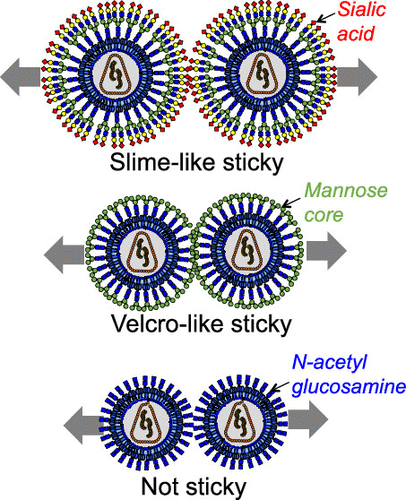Our official English website, www.x-mol.net, welcomes your feedback! (Note: you will need to create a separate account there.)
Establishing Rules for Self-Adhesion and Aggregation of N-Glycan Sugars Using Virus Glycan Shields
Langmuir ( IF 3.9 ) Pub Date : 2020-11-13 , DOI: 10.1021/acs.langmuir.0c01953 Eric Ogharandukun , Wintana Tewolde , Elbethel Damtae , Songping Wang , Andrey Ivanov , Namita Kumari , Sergei Nekhai , Preethi L. Chandran
Langmuir ( IF 3.9 ) Pub Date : 2020-11-13 , DOI: 10.1021/acs.langmuir.0c01953 Eric Ogharandukun , Wintana Tewolde , Elbethel Damtae , Songping Wang , Andrey Ivanov , Namita Kumari , Sergei Nekhai , Preethi L. Chandran

|
The surfaces of cells and pathogens are covered with short polymers of sugars known as glycans. Complex N-glycans have a core of three mannose sugars with distal repeats of N-acetylglucosamine and galactose sugars terminating with sialic acid (SA). Long-range tough and short-range brittle self-adhesions were observed between SA and mannose residues, respectively, in ill-defined artificial monolayers. We investigated if and how these adhesions translate when the residues are presented in N-glycan architecture with SA at the surface and mannose at the core and with other glycan sugars. Two pseudotyped viruses with complex N-glycan shields were brought together in force spectroscopy (FS). At higher ramp rates, slime-like adhesions were observed between the shields, whereas Velcro-like adhesions were observed at lower rates. The higher approach rates compress the virus as a whole, and the self-adhesion between the surface SA is sampled. At the lower ramp rates, however, the complex glycan shield is penetrated and adhesion from the mannose core is accessed. The slime-like and Velcro-like adhesions were lost when SA and mannose were cleaved, respectively. While virus self-adhesion in forced contact was modulated by glycan penetrability, the self-aggregation of the freely diffusing virus was only determined by the surface sugar. Mannose-terminal viruses self-aggregated in solution, and SA-terminal ones required Ca2+ ions to self-aggregate. Viruses with galactose or N-acetylglucosamine surfaces did not self-aggregate, irrespective of whether or not a mannose core was present below the N-acetylglucosamine surface. Well-defined rules appear to govern the self-adhesion and -aggregation of N-glycosylated surfaces, regardless of whether the sugars are presented in an ill-defined monolayer, or N-glycan, or even polymer architecture.
中文翻译:

使用病毒聚糖屏蔽建立N-糖基糖自粘和聚集的规则
细胞和病原体的表面覆盖着称为聚糖的糖类短聚合物。复杂的N-聚糖的核心是三个甘露糖,N-乙酰氨基葡糖和半乳糖的末端重复序列以唾液酸(SA)终止。在不确定的人工单层中,分别在SA和甘露糖残基之间观察到了远距离的韧性和近距离的脆性自粘。我们研究了当残留物以N-聚糖结构(表面具有SA,核心是甘露糖以及其他聚糖)呈现在N-聚糖结构中时,这些粘附力是否以及如何翻译。两种复杂N的假型病毒-聚糖屏蔽物在力谱(FS)中结合在一起。在较高的斜率下,在防护罩之间观察到粘液状粘着,而在较低的速率下观察到粘扣状粘着。较高的接近率会压缩整个病毒,并且会采样表面SA之间的自粘性。然而,在较低的斜率下,复杂的聚糖屏蔽层被穿透,并且获得了来自甘露糖核的粘附。当SA和甘露糖被切割时,粘液状和维可牢尼龙搭扣状的粘连消失。虽然病毒在强迫接触中的自我粘附是通过聚糖的渗透性来调节的,但自由扩散病毒的自我聚集只能由表面糖来确定。甘露糖末端病毒在溶液中自我聚集,而SA末端病毒则需要Ca 2+离子自聚集。具有半乳糖或N-乙酰氨基葡萄糖表面的病毒不会自聚集,无论在N-乙酰氨基葡萄糖表面下方是否存在甘露糖核心。定义明确的规则似乎可以控制N-糖基化表面的自粘和聚集,而不管糖是否以定义不清的单层,N-聚糖甚至聚合物结构形式存在。
更新日期:2020-11-25
中文翻译:

使用病毒聚糖屏蔽建立N-糖基糖自粘和聚集的规则
细胞和病原体的表面覆盖着称为聚糖的糖类短聚合物。复杂的N-聚糖的核心是三个甘露糖,N-乙酰氨基葡糖和半乳糖的末端重复序列以唾液酸(SA)终止。在不确定的人工单层中,分别在SA和甘露糖残基之间观察到了远距离的韧性和近距离的脆性自粘。我们研究了当残留物以N-聚糖结构(表面具有SA,核心是甘露糖以及其他聚糖)呈现在N-聚糖结构中时,这些粘附力是否以及如何翻译。两种复杂N的假型病毒-聚糖屏蔽物在力谱(FS)中结合在一起。在较高的斜率下,在防护罩之间观察到粘液状粘着,而在较低的速率下观察到粘扣状粘着。较高的接近率会压缩整个病毒,并且会采样表面SA之间的自粘性。然而,在较低的斜率下,复杂的聚糖屏蔽层被穿透,并且获得了来自甘露糖核的粘附。当SA和甘露糖被切割时,粘液状和维可牢尼龙搭扣状的粘连消失。虽然病毒在强迫接触中的自我粘附是通过聚糖的渗透性来调节的,但自由扩散病毒的自我聚集只能由表面糖来确定。甘露糖末端病毒在溶液中自我聚集,而SA末端病毒则需要Ca 2+离子自聚集。具有半乳糖或N-乙酰氨基葡萄糖表面的病毒不会自聚集,无论在N-乙酰氨基葡萄糖表面下方是否存在甘露糖核心。定义明确的规则似乎可以控制N-糖基化表面的自粘和聚集,而不管糖是否以定义不清的单层,N-聚糖甚至聚合物结构形式存在。


























 京公网安备 11010802027423号
京公网安备 11010802027423号